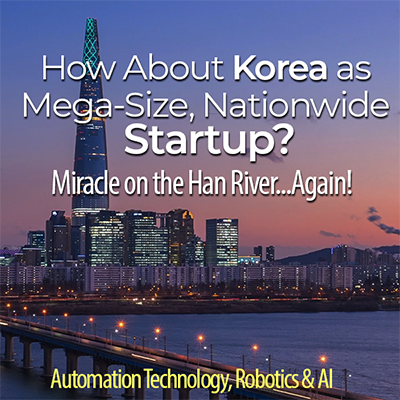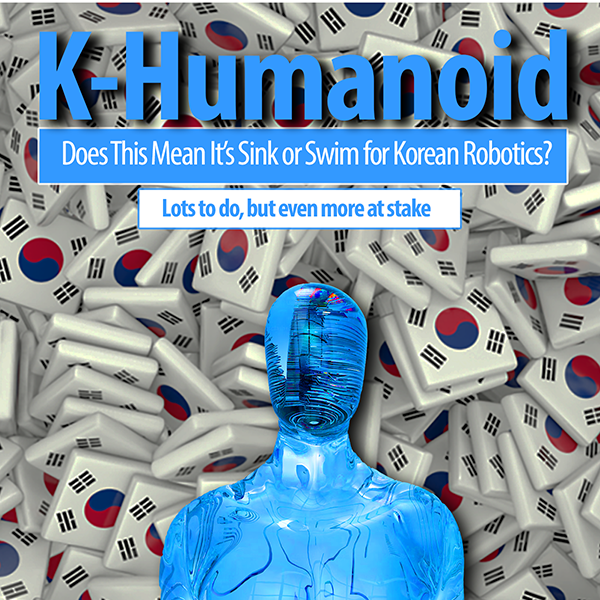
Lots to do, but even more at stake!
K-Humanoid: Sink or Swim for Korean Robotics?
Making Korea relevant in the age of intelligent machines. The challenges are immense: out-innovating global giants, nurturing interdisciplinary collaboration, and transitioning from hardware-centric models to AI-driven ecosystems.
Rooting for Korean Robotics: 7:06 runtime
Lots to do
Even with a population barely above 50 million, Korea has always punched way above its weight class, especially way back decades ago, battling to win the Miracle on the Nan River (1972-1976).
More recently, Korea has given the world K-Pop, K-Cuisine, K-Beauty, K-Fashion, K-Tech, K-Movies, a bunch of little Ks in between, and these days has rolled out maybe its most ambitious and crucial national challenge yet: K-Bots, specifically, the K-Humanoid Alliance, which even more than a few Korean insiders are calling a “sink or swim” moment for Korean robotics.
Here’s but one of the uncomfortable viewpoints at-large in Korea: “At this rate, I’m not sure if Korean robot firms will remain within the next five to ten years.”
—Oh Min-hwan, Director at Yuil Robotics.
And he’s way not alone in that thinking.
See related: Hyundai Expands Korea’s Grand Robotics Plan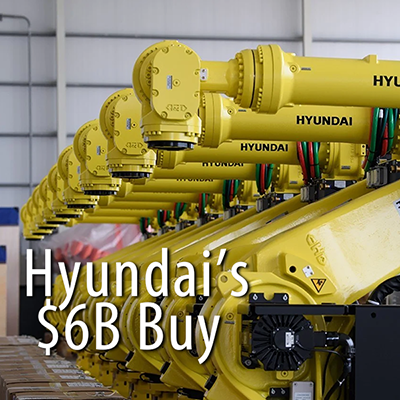 The crux of the problem, and of Oh’s grim concern, is Korea getting squeezed by its two East Asian neighbors: China and Japan. “The rapid rise of Chinese and Japanese competitors, armed with aggressive pricing strategies (as much as 30% to 40% discounts), advanced manufacturing capabilities, and being out-competed in AI (artificial intelligence) has left Korean firms struggling to maintain their foothold in both domestic and global markets.”
The crux of the problem, and of Oh’s grim concern, is Korea getting squeezed by its two East Asian neighbors: China and Japan. “The rapid rise of Chinese and Japanese competitors, armed with aggressive pricing strategies (as much as 30% to 40% discounts), advanced manufacturing capabilities, and being out-competed in AI (artificial intelligence) has left Korean firms struggling to maintain their foothold in both domestic and global markets.”
Industry leaders warn that without immediate intervention, Korea’s robotics sector could be pushed to the brink of collapse within the next decade.
See related: What Korea’s Robotics Industry Fears Most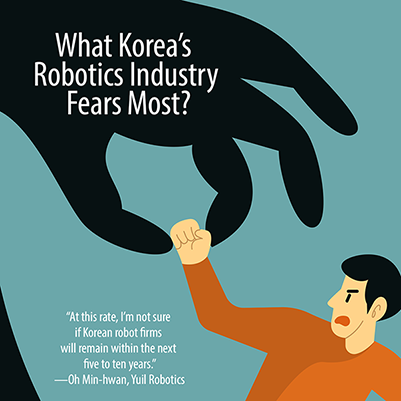
Korea’s response will manifest itself, hopefully, as a massive, nationwide reply in the following way: Korea recently unveiled its most ambitious robotics initiative to date ($700 million): the K-Humanoid Alliance, a coalition of over 40 corporations, universities, and research institutions are united under a single mission—to secure global leadership in humanoid robotics by 2030.
Spearheaded by the Ministry of Trade, Industry and Energy (MOTIE), the alliance represents a bold national strategy to dominate a sector projected to grow 25-fold to $38 billion by 2035. Yet, beneath this optimism lies a palpable sense of urgency. Engineers, academics, and industry leaders warn that without the success of the K-Humanoid Alliance, Korea’s robotics industry risks falling irreversibly behind global competitors, jeopardizing its economic future and technological sovereignty.
Officially, the Ministry explains it all this way: “K-Humanoid Alliance, is a consortium comprising more than 40 domestic robotics manufacturers, component suppliers, and research institutions (April 10). The participating organizations put pen to paper on a memorandum of understanding (MOU), pledging to collaborate on the joint development of humanoid AI systems.”
Not a binding contract, an MOU is much looser. Korea, it could be said, is hanging its future on an MOU: a non-binding expression of agreement to explore collaboration of a particular goal. At least it is recognition that the homeland is in deep trouble and that everyone must pull together.
“Dream Team” unifies against obsolescence
The K-Humanoid Alliance is no ordinary consortium. Dubbed a “dream team” by MOTIE, it brings together robotics heavyweights like Samsung-owned Rainbow Robotics, HD Hyundai Robotics, and Doosan Robotics, alongside battery titans LG Energy Solution and SK On, semiconductor innovators Rebellions and DEEPX, and academic powerhouses such as Seoul National University (SNU) and Korea Advanced Institute of Science & Technology (KAIST).
The “Dream Team’s” laundry list has “hard” problems to solve
The alliance’s five strategic objectives:
- AI foundation model,
- Advancing high-performance hardware,
- Innovating core components,
- Fostering industry-academia collaboration,
- Boosting global competitiveness
The five are designed to address Korea’s critical weaknesses in AI-driven autonomy and hardware-software integration, where it currently trails the U.S. and China.
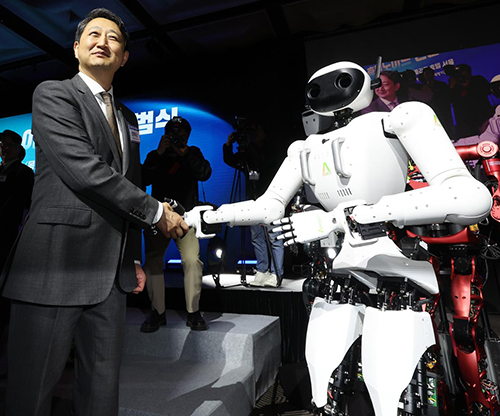 At the heart of the initiative is a centralized AI platform, slated for completion by 2028, which will serve as the “brain” for humanoids, enabling autonomous decision-making across logistics, manufacturing, and healthcare. Equally ambitious are hardware targets: lightweight robots (under 60 kg) with 50+ joints, 20 kg payload capacity, and mobility exceeding 2.5 meters per second. To power these systems, the alliance aims to develop custom low-power AI semiconductors and high-density batteries, leveraging collaborations between battery manufacturers and robotics firms.
At the heart of the initiative is a centralized AI platform, slated for completion by 2028, which will serve as the “brain” for humanoids, enabling autonomous decision-making across logistics, manufacturing, and healthcare. Equally ambitious are hardware targets: lightweight robots (under 60 kg) with 50+ joints, 20 kg payload capacity, and mobility exceeding 2.5 meters per second. To power these systems, the alliance aims to develop custom low-power AI semiconductors and high-density batteries, leveraging collaborations between battery manufacturers and robotics firms.
Government backing is robust, with MOTIE pledging $150 million in 2025 for R&D, infrastructure, and testing. Additional measures include a proposed “humanoid fund” for startups and expanded educational programs to cultivate talent. “This sector is pivotal to our manufacturing future. We must act swiftly to secure global leadership,” stressed MOTIE Minister Ahn Duk-geun.
The Fear Factor: Why Korea’s Robotics Industry Is on Edge
Despite these efforts, industry insiders voice profound concerns.
According to Korea’s K-Humanoid document, here are the core fears driving this “sink or swim” moment in Korea and its technology:
The AI innovation gap: While Korean firms excel in mechanical engineering, they lag in AI software, particularly in generative AI and autonomous learning systems. U.S. companies like Tesla, Figure AI, Boston Dynamics, and Agility Robotics, alongside Chinese firms such as Unitree, are rapidly advancing AI-humanoid integration, leaving Korea reliant (other than domestic producer Rainbow Robotics) on foreign AI frameworks . Without a homegrown AI foundation model, Korean robots risk becoming mere hardware vessels for foreign intelligence.
- Fragmented collaboration: Historically, Korea’s robotics ecosystem has been siloed, with corporations, academia, and startups operating in isolation. This fragmentation has stifled innovation cycles and delayed commercialization. For instance, while Hyundai’s $21 billion U.S. investment—including its partnership with Boston Dynamics—showcases global ambition, domestic integration of similar technologies remains sluggish.
- Global competition and market pressures: The humanoid robotics race is intensifying. China’s state-backed initiatives and the U.S.’s private-sector dynamism threaten to overshadow Korea’s efforts. Analysts warn that Korea’s window to catch up is narrowing, as competitors pour billions into R&D and talent acquisition.
There’s a lot to do, but there’s even more at stake. These fears are compounded by demographic challenges. Korea’s aging population and shrinking workforce amplify the demand for automation, yet the inability to produce advanced humanoids could force reliance on imported systems, eroding the domestic industry.
What if the K-Humanoid Alliance falters?
Economic vulnerability: Robotics is a linchpin of Korea’s manufacturing-led economy. Humanoids promise to revolutionize sectors from automotive assembly to elderly care, but failure to innovate could coke these opportunities to foreign players. LG Electronics and CJ Logistics, both alliance members, plan to test humanoids in logistics depots and smart factories—applications that could redefine efficiency. Without competitive indigenous solutions, Korea’s export-driven economy risks losing its edge.
Technological dependence: Korea’s semiconductor and battery industries are global leaders, yet the absence of tailored components for humanoids (e.g., low-power AI chips, tactile sensors) could force reliance on foreign suppliers. Rebellions and DEEPX are tasked with closing this gap, but delays might leave Korea importing critical technologies it once mastered.
Talent drain: The alliance’s emphasis on education—expanding internships and robotics curricula—aims to nurture a skilled workforce. However, without visible success, top engineers and researchers may migrate to opportunities abroad, exacerbating the innovation deficit.
Nothing is easy. Can the K-Humanoid Alliance master every threat?
AI foundation model: By creating a unified AI platform, Korea seeks to break free from dependency on foreign AI frameworks. Professor Jang Byoung-Tak, a leading AI researcher in the alliance, emphasizes that localized AI training using Korean language and industrial data will enhance contextual adaptability—a critical advantage in niche markets.
- Hardware-software synergy: The integration of Samsung’s manufacturing prowess with KAIST’s research capabilities aims to bridge the innovation-commercialization gap. Hyundai’s factory trials with Boston Dynamics’ Atlas robots exemplify the practical collaboration needed to refine humanoids in real-world settings.
- Global partnerships: While fostering domestic innovation, the alliance recognizes the need for international ties. Hyundai’s U.S. investments and partnerships with firms like Nvidia provide channels for knowledge exchange, mitigating the risks of insularity.
Sink-or-swim moment for Korean robotics?
The K-Humanoid Alliance represents more than a bid for market dominance—it is a defensive strategy against obsolescence. For Korean engineers and CEOs, the initiative is a referendum on the nation’s ability to adapt to a new industrial era defined by AI and automation.
The challenges are immense: out-innovating global giants, nurturing interdisciplinary collaboration, and transitioning from hardware-centric models to AI-driven ecosystems. Yet, the consequences of inaction are dire. Without a cohesive, well-funded effort, Korea’s robotics industry could fragment further, ceding ground to competitors and undermining its economic pillars.
As Minister Ahn Duk-geun asserted, the time to act is now. The K-Humanoid Alliance is not merely an ambitious project—it is Korea’s lifeline to relevance in the age of intelligent machines. Success will secure its place as a global leader; failure could relegate its robotics dreams to history.

